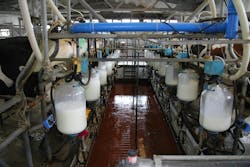New Study: H5N1 Virus Can Remain Stable on Milking Equipment for Hours
According to a June 27 press release, research from the University of Pittsburgh School of Medicine and Emory University in the journal Emerging Infectious Diseases shows that the H5N1 virus remains stable on commercial milking equipment for at least one hour.
“Our data supports that milking equipment surfaces can stay contaminated for a long time, increasing the potential spread from a sick animal to a person,” said lead author Valerie Le Sage, research assistant professor of microbiology and molecular genetics with Pitt’s Center for Vaccine Research. “These findings underscore the importance of face shields, masks and eye protection, and enhanced sanitization of equipment between cows to reduce the risk to workers and to minimize the spread between the animals.”
Researchers, according to the release, investigated the stability of infectious virus particles in unpasteurized milk droplets on metal and rubber components of commercial milking equipment.
“Their findings underscore the heightened risk of bird flu exposure for dairy farm workers,” notes the release.
Further, “Clinical symptoms of bird flu can range from mild fever and cough to shortness of breath and pneumonia and can be lethal. Since March 2024, when the bird flu virus was first detected in dairy cattle in the United States, the virus has spread across state lines and infected at least three people. According to the U.S. Centers for Disease Control and Prevention, the current risk to the general public remains low, but flu viruses can quickly adapt to spreading from person to person.”
In April, we reported that the FDA had released further updates regarding the outbreak of highly pathogenic avian influenza (HPAI) impacting dairy cows in multiple states.
The FDA and USDA continue to indicate that the U.S.’s commercial milk supply is safe. They emphasize that the pasteurization process, which “kills harmful bacteria and viruses by heating milk to a specific temperature for a set period of time,” continues to keep milk safe. 99% of the commercial milk supply produced on dairy farms in the U.S. “comes from farms that participate in the Grade ‘A’ milk program and follow the Pasteurized Milk Ordinance.” The FDA and CDC are collaborating closely to ensure “the continued effectiveness of the federal-state milk safety system.”

